The best varieties of cherries for central Russia
It is impossible to imagine the summer harvest without cherries. Burgundy berries with glossy skin are grown for personal consumption and sale, used for processing and freezing. Cherry pulp is distinguished not only by its juiciness and pleasant taste. It contains vitamins A and C, useful acids. To get a rich harvest, it is important to choose a variety based on the climatic conditions of the growing region. For central Russia, this is a frost-resistant cherry with strong immunity and resistance to pests.
Cherry varieties for central Russia
There are several classifications of cherries. By ripening period - early and late, by taste - sour and sweet. There is a self-fertile cherry - one that does not require pollinating insects; large-fruited - with large fruits.
Let's consider a description of the best varieties of cherries for central Russia.
Large
Large cherries are used for transportation, storage, preservation, and fresh consumption. The size of the fruit depends not only on the characteristics of the variety, but also on the amount of mineral and organic fertilizers. Balanced plant nutrition ensures a rich harvest.
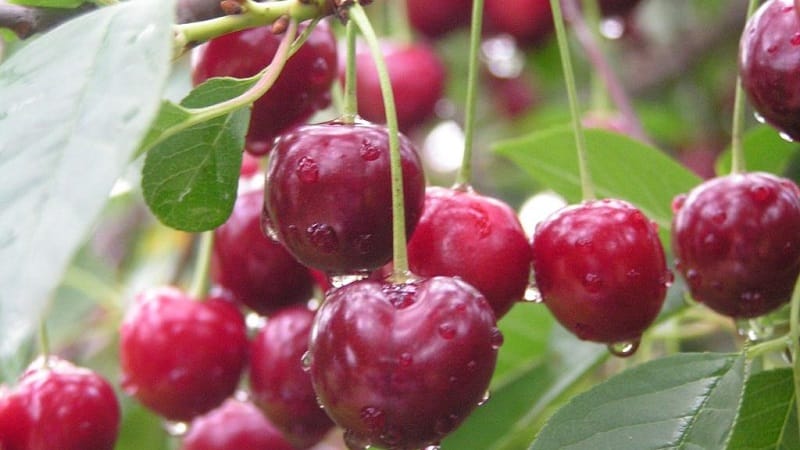
Miracle cherry
Miracle cherry - a popular hybrid of cherries and sweet cherries. The fruits are very large - weighing 8-10 g. The shape is round, flattened, the color is rich burgundy. The peel is dense, glossy. The berries have a pleasant and very sweet pulp. Thanks to its dense peel, Miracle Cherry is transportable.The trees are vigorous, the crown is spreading, and in appearance it looks more like a sweet cherry than a cherry. The variety is resistant to diseases, drought and frost. It is universal in use - cherries are good in fresh and processed forms.
Favorite
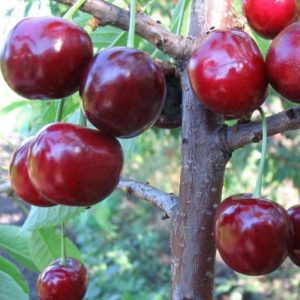
Early ripening winter-hardy variety. The advantages include self-fertility and early fruitfulness - the harvest is harvested 3-4 years after planting. The tree is medium-sized, the crown is flattened, the density is average. The fruits are rounded and flattened, weighing from 5 to 8 g. The peel is cherry-colored, the flesh is red, juicy. The taste is sweet and sour, harmonious. The favorite is unpretentious in cultivation and is rarely affected by diseases.
Self-fertile
Summer residents especially love self-fertile varieties - there is no need to worry about the presence of pollinating insects or specially plant other cherry or sweet cherry trees nearby for cross-pollination.
Amorelle pink
The ultra-early cherry variety Amorel pink is distinguished by high yield and early fruiting - the fruits ripen within 3-4 years from the moment the seedlings are planted. The height of the tree is 2.5-3 m, the crown is sparse and spreading. The berries are flat-round, weighing 4-5 g per one.
The peel is thin, light pink in color. The taste is sweet and sour, the small bone is easily separated from the pulp. The juice is colorless. The stalk is firmly attached to the fruit, the detachment is wet. Pink amorel does not crumble after ripening, retains its taste and juiciness.
Lyubskaya
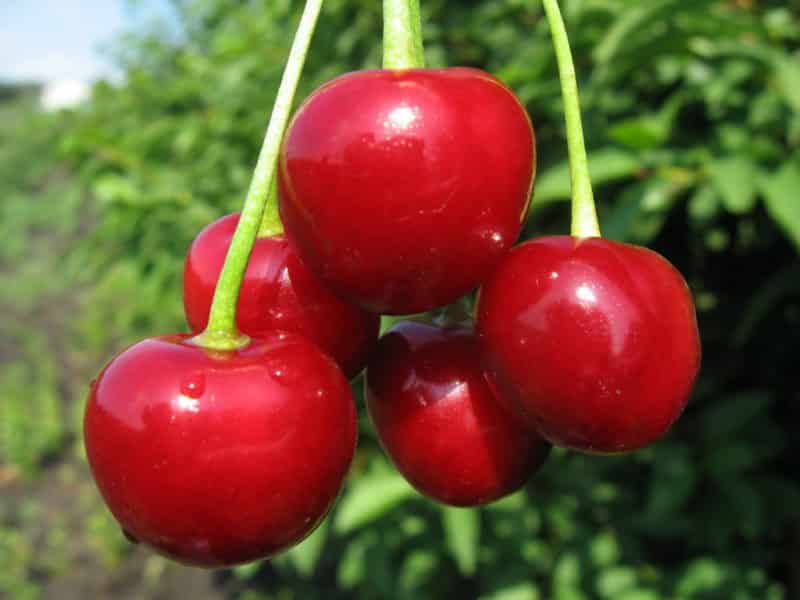
Late-ripening winter-hardy variety. The tree is bushy and low-growing, so it will decorate any summer cottage. The crown is round and drooping, the leaves are medium-sized, green. The weight of the fruit is 4 g, the shape is round, obtuse-heart-shaped. The skin is dark red, dense and glossy. The taste is sour, the flesh is juicy. The bone is small and round.
Lyubskaya cherry is unpretentious in cultivation, however, it is recommended to regularly spray the trees with Bordeaux mixture to protect against coccomycosis and moniliosis, and also to mold the plant. Juices and wine are prepared from Lyubskaya; it is rarely consumed fresh. The tree bears fruit for 2-3 years; an adult plant produces up to 15 kg per summer. Cherry is frost-resistant and is not susceptible to the death of flower buds.
Attention! The crown is formed in summer, autumn or spring. Summer residents trim shoots that obscure the top of the tree. Otherwise, the tree will become sick and the yield and taste of the fruit will decrease. For shaping, use curved garden shears.
The sweetest
Sweet cherries are the dream of every summer resident. Delicious and the juicy berry pulp will be an excellent addition to ice cream or sorbet; housewives bake cherry pies and cakes.
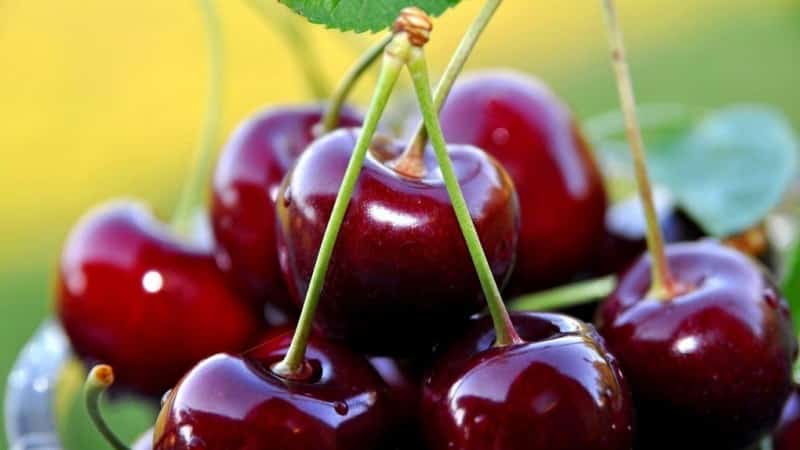
Memory of Sakharov
Mid-late universal variety. The tree is medium-sized, the crown is pyramid-shaped, dense. The fruits are oval, weighing 3 g, the peel is medium thick, dark red. The pulp is tender and juicy, sweet with a rich aroma. The peduncle is thin, the detachment is semi-dry. The Pamyat Sakharov variety is winter-hardy, slightly affected by coccomycosis, and is universal in use. Also, the advantages of cherries include good transportability, partial self-fertility and early fruitfulness.
In memory of Enikeev
The early-ripening variety is drought and frost-resistant; the trees begin to bear fruit in the fourth year after planting. The leaves are large, dark green, the crown is of medium density. The fruits are one-dimensional, weight one - 4-5 g, color dark red or burgundy. The pulp is juicy and tender, the taste is sweet with a slight pleasant sourness. The berries ripen smoothly and do not fall off or crack.They are distinguished by their transportable qualities and are used in cooking. Cherry flowers are resistant to spring frosts, the tree tolerates drought and heat.
Late
The late ripening harvest ripens in late July - early August. Cherries are grown for sale or processing; late varieties tolerate long-distance transportation well, do not crack on the road, and retain their taste and presentation.
Youth
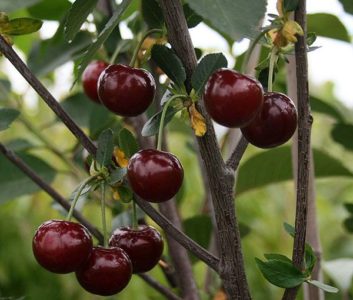
Molodezhnaya is a mid-late variety, but in most regions of central Russia it produces a harvest only in August. The advantages of the variety are self-fertility, versatility, small tree size. Youth will fit even into a compact garden plot, since it takes up little space.
The crown is spreading, the density is average. The berries are wide-round, weighing 4-5 g, rich burgundy color, thin stalk. The taste is sweet and sour and juicy, the flesh is tender and dense. The stone is round, medium in size, and easily separated from the pulp. The berries are made into aromatic jam or frozen for the winter in the freezer.
Lotovaya
The trees are vigorous with a spreading and dense crown. With age, she becomes drooping. The variety is not affected by fruit rot, is resistant to coccomycosis, tolerates drought, and is self-fertile. The weight of the berry is 4-5 g, the shape is barrel-shaped. The peel is dark burgundy, with a black tint. The peel is strong and glossy. The stalk is long, the flesh is dark red, pleasant. The taste is sweet and sour, harmonious. The stone is oblong and large.
Attention! To stimulate growth, gardeners use mineral and organic fertilizers. Superphosphate, ammonium nitrate, urea, mullein infusion, Nitrophoska, and manure are added to the soil. They spend 2-3 per season feeding, after thoroughly watering the tree with water at room temperature. Afterwards the soil is loosened and fertilizers are applied.
Early
Early cherries ripen in June. The fruits are collected and eaten fresh, and can also be frozen or dried for the winter. In terms of taste, early-ripening cherries are not inferior to late varieties; the pulp is pleasant to the taste and aromatic.
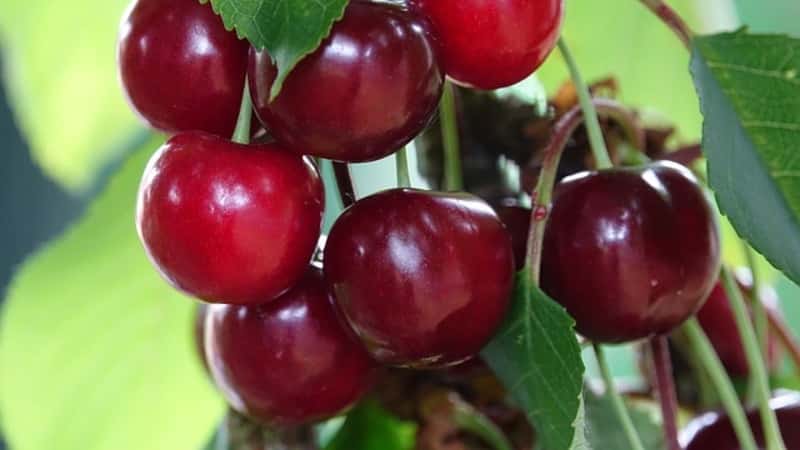
Aphrodite
Aphrodite cherries are harvested between June 10-15. Tree of medium height, rounded crown. The fruits are dark red, the skin is dense and shiny. The shape of the berries is flat-round, the flesh is burgundy, dense. The weight of one fruit is about 6 g. The taste is aromatic, sweet with a slight sourness. Aphrodite is resistant to drought and frost, suitable for processing and fresh consumption. The tasting rating of the variety is 4.8 points.
Bagryannaya
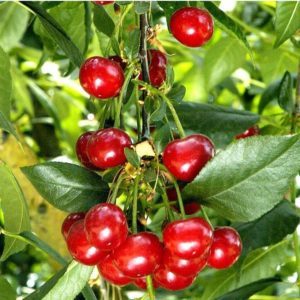
The partially self-fertile variety of Bagryannaya cherry is universal in use. The tree is compact, 2 m high, the crown is compressed, rounded. The weight of the berry is about 4 g, the shape is round, the color is red-burgundy. The taste is sweet and sour, refreshing, the flesh is dense and juicy. The small bone is easily separated from the pulp. During the season, up to 6 kg of crop is harvested from a tree. Crimson is harvested around the twentieth of June.
The best low-growing cherry varieties for central Russia
Low-growing (dwarf) trees resemble bushes in appearance - low plants with a compact crown will decorate a garden plot. Summer residents plant low-growing varieties not only for harvesting, but also for decorative purposes - for landscaping the garden or creating a hedge.
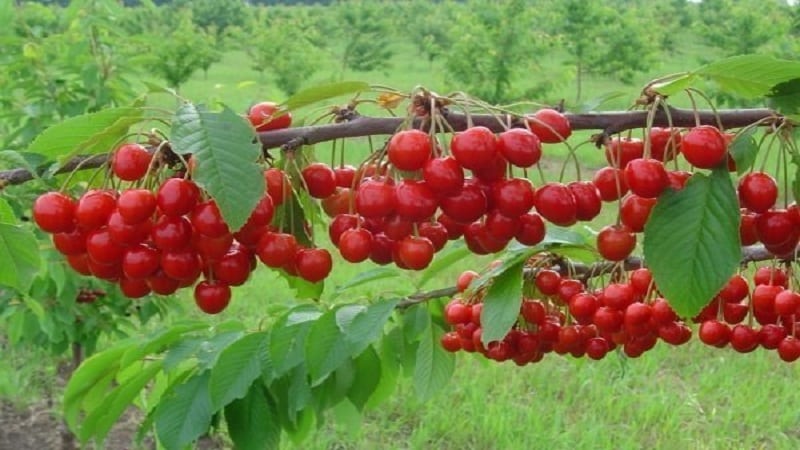
Anthracite
The mid-late cherry variety Anthracite is unpretentious in care. The tree is bushy, the crown is spreading. The weight of one cherry is 4 g, the shape is round-heart-shaped. The skin is dark burgundy. The pulp is medium density, dark red in color. The taste of the berries is sweet and sour, pleasant.Anthracite is used for winter preparation and freezing. Other advantages include partial self-fertility and resistance to frost. The harvest is harvested between July 16-23. If the storage rules are followed, the shelf life of Anthracite is 45 days.
Mtsenskaya
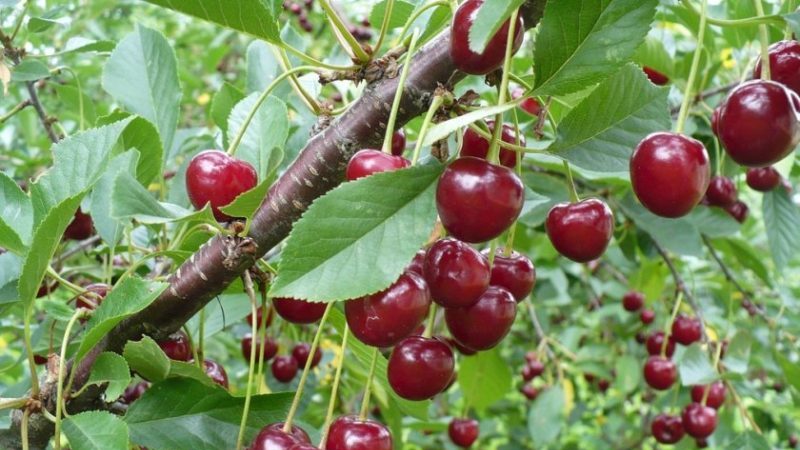
Technical variety with medium-late ripening period. The tree is low-growing with an oval-round spreading crown. Mtsenskaya early-fruiting - summer residents harvest 3-4 years after landings. The leaves are matte, dark green, medium size. The fruits are round and one-dimensional, red in color. The weight of the berry is 3-4 g, the taste is sweet and sour. The variety is resistant to viral diseases and tolerates long periods of lack of watering and hot weather. The berries attract gardeners with their appetizing spring appearance.
Octave
Mid-early winter-hardy variety for cultivation in central Russia. Octave is valued for its immunity to coccomycosis and moniliosis, partial self-fertility, high and stable yield. The crown is compact but dense, so trees are also planted for decorative purposes. The fruits are flat-round, weighing 4-5 g, the skin is burgundy and shiny. The separation from the stalk is dry, the small stone is easily separated from the pulp. The taste of cherries is sweet and delicate, with a slight sourness and a pleasant tart aftertaste.
Attention! The ripeness of cherries is determined by the appearance of the fruit: they become elastic and acquire a color characteristic of the variety. For storage and transportation, it is recommended to pick berries 5-7 days before full ripening. The cherries will ripen on their own.
Conclusion
Among the self-fertile varieties, pink Amorel and Lyubskaya cherries are distinguished - they are distinguished by their unpretentiousness in care, do not require special agrotechnical knowledge and skills. Among the sweet ones - Memory of Sakharov and Memory of Enikeev.Their pleasant and aromatic pulp will appeal to adults and children. Dwarf varieties are also popular - Anthracite, Oktava, Mtsenskaya. Small bushy trees take up little space on the site and decorate it with their appearance.